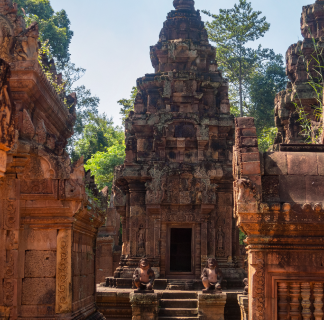Oracles
By Sri Skanda’s Warrior of Light
Oracles are a collection of over forty powerful directives given directly by Sri Skanda, Son of Siva, from the realms of Sivaloka to spiritual aspirants on this earth plane through His chosen messenger, Sri Hilda Charlton. These teachings that Bhagavan Skanda rendered to Hilda were delivered over a five-year period at the Hindu Temple Society of North America, in Queens, New York.

Oracles are a collection of over forty powerful directives given directly by Sri Skanda, Son of Siva, from the realms of Sivaloka to spiritual aspirants on this earth plane through His chosen messenger, Sri Hilda Charlton. These teachings that Bhagavan Skanda rendered to Hilda were delivered over a five-year period at the Hindu Temple Society of North America, in Queens, New York.
— Dr. Alagappa Alagappan,
Founder, The Hindu Temple Society of North America


Replete with jnaana, love, and power, Sri Skanda’s soul stirring eloquent discourses leads spiritual aspirants to self-realization and victory over the dark forces of their lower selves. As soon as you make a decisive stand to put Sri Skanda’s teachings into action to the highest of your ability, you will savor the nectar of wisdom contained in His spoken words, be embraced by the warmth of His Love, and be graced by His gift of freedom from rebirth.
Bhagavan Sri Skanda is known as Murugan and by numerous other names in different parts of India and Ceylon. His story dates back centuries before Christ. The scene of Skanda’s birth is set in the Himalayas. His birth and life are written in the Skanda Purana, an epic poem which dates from the fifth century A.D.
In India, countless shrines are dedicated to Him, but there are six major ones, each with a separate name. These six as a whole are known by the title, “Aarupaddai Veedu.”
In Ceylon, in the heart of a forest with roaming elephants, leopards and other beasts, is the Sri Skanda shrine of Katragama, famed for its many healings and miracles. The fire-walking ceremony is one of the many unexplained phenomena that regularly occur there. The many forms of Skanda are worshiped in numerous ways. The priests worship Him in elaborate rites and ceremonies. The aboriginal Vedda invokes Him with dances in the primitive manner of the woods. The philosopher meditates on Him in silence as the Supreme All-Pervading Spirit of the Universe, the Essence from which all is manifest.
Skanda is known to have arrived in Ceylon in the remote age when it belonged to Lemuria, a vast continent that stretched from Madagascar to near Australia and included India as well as Ceylon. This territory was once ruled by a titan who became the terror of the Celestials who had taken form to live upon the Earth at that period. In answer to their prayers, the God Skanda was incarnated as Son of the Supreme God Siva. He led a mighty host to Ceylon. It is said that the sky and earth were confounded, the earth shaken at its foundation, such was the mighty uproar of this battle among the Gods. Skanda destroyed the titan with His vel, or lance, a symbol which typifies Skanda’s energy of wisdom. Once the titan was finally defeated, he was granted forgiveness by Skanda for his sins and was changed into a peacock, upon which Skanda now rides; therefore, the peacock, one of whose many names is Myol, has great significance in the lore of Skanda. When Skanda wishes to make Himself known, one might see a colorful peacock feather appear or even see a vision of a peacock with tail raised. In this, Skanda symbolizes the highest quality of the Godhead which conquers the qualities of the lower nature. Riding upon the transformed titan represents turning the lower energies of God’s creation into higher uses.
While writing this book, I thought, “Can I write about Sri Skanda and not about his older brother, Ganesha, the first son of Siva?” Of course, I can’t. With that in mind, my thoughts flew backwards to my early days in the Orient. I remembered saying in jest and fun to a newly found Hindu friend who had a picture of Ganesha, “Who would worship an elephant?” And I merrily laughed in fun, though not in ridicule.
A day later, while sitting in meditation, who appeared in my inner vision but an elephant with laughing eyes. I apologized and never made fun again. I have learned to love Sri Ganesha’s form, but rarely in any statue have I seen it correctly carved, especially the face which, though full of mirth, is the epitome of wisdom itself.
When I had learned to appreciate, understand and love Ganesha’s elephant form, He gave to me a gift — to see Him as His True Self, as He is in His celestial abode. I awakened on the ceremonial day of His birthday. Ganesha stood there on my altar in all His splendor, in His princely celestial form. He looked very much like Skanda. I said, “You are so beautiful, as beautiful as my Skanda,” and then I laughingly said, “Well, nearly as beautiful, not quite.” He serenely smiled, and all day He remained in this glorious appearance. On the next day, He returned to His elephant form.
In Jaffna in southern Ceylon is an ageless, ancient temple, carved in beautiful stone. Inside is one small shrine which I often visited before going to see Yogi Swamigal, a great saint who lived in Jaffna. When I would go to him, he would always say, “Have you been visiting the stone swamis again?” I would say, “Does it matter?” and he would chuckle, “No.”
At this particular time, I was having many troubles and felt I had reached the end of my rope. I wanted to go home, but was not given permission to return to the United States by the Masters. I walked up the three small stairs to the little shrine. It was very dark inside the inner sanctum, where a black carved stone statue of Ganesha in His elephant form was enshrined. I could not see the form in the darkness. With tears running down my cheeks, I heard myself call out, while standing in front of a Hindu shrine, “Jesus! Help me, Jesus! Please, Jesus! Help me!”
Browse through
References
- Alagappan, Alagappa. (Charlton, Hilda. Skanda. New York: Golden Quest, 1989.)
